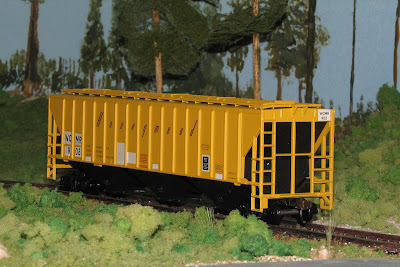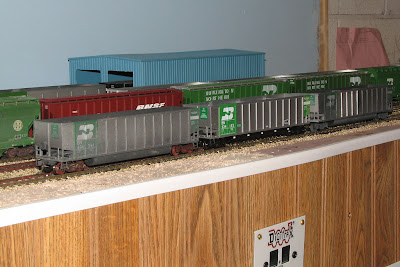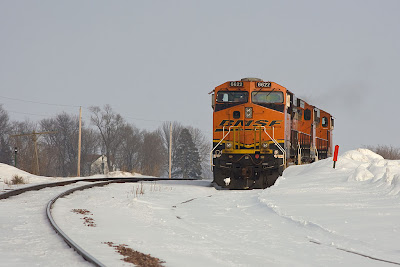
Having come home from the World's Greatest Hobby show in St. Paul this winter with a shiny new Digitrax Zephyr Xtra and UT4 throttle, the age of DCC has settled over Casa Del L4T. MN Chris has been a great help as I learn new things about model railroading, especially with decoder installs that are currently above and beyond my modest ability.
One of the things I wanted to do was start to install remote "plug ins" for the UT 4 so I could follow my train around the layout. Someday I hope to have a fancy DT402D duplex radio throttle and associated receiver but for now I'm stuck in the plug in age. Hence the need for more ports to connect the throttle.
Sniffing around the internet revealed
Railway Bob's site, where the deepest darkest secrets of the Digitrax "LocoNet" are discussed. Digitrax makes it easy to build a LocoNet using RJ12 phone cables and the UP5 panel. Here's a photo of the single UP5 I brought home with me, installed on the layout.

This view from underneath the layout shows how easy these panels are to connect-the LocoNet simply plugs in using an RJ12 cable, and you daisy chain it on to the next device using another cable.

However, the UP5's run in the $15 to $20 each range, and I wanted to be able to use my throttle in at least half a dozen places. Surely, I thought, there must a
better cheaper way. And so I arrived at Railway Bob's idea of using RJ12 phone jacks.
Now the thing to remember is RJ12 means 6 wires. When you get to the store and start looking at merchandise you'll find that there are lots of phone jacks, but the great majority are RJ11. These have the same physical configuration as RJ12 jacks, but only the center 4 slots are populated with connectors. So they won't work for a proper LocoNet. But if you are persistent, you'll come across some RJ12 jacks, and with any luck they'll be on clearance. That's what happened to me. Twice. So I scooped up a bunch of them, along with some 6 conductor phone cable, and retreated to the basement. And after a little time with a borrowed crimper, a healthy dose of blue wire nuts, and some finaggling, I ended up with a working LocoNet. Here's my first home brewed panel, from the front:

And here's what one of them looks like from behind:

I know they're not as neat as the UP5's, but you have to remember we are talking about a near 90% price discount. And all you have to do is connect white to white, blue to blue, red to red, etc. Not too tough.
Railway Bob's info is a big help here. I do have one extra tip that I didn't see on his page-if possible, use solid 6 conductor wire. The flat cable with stranded conductors is MUCH more difficult to work with. I've done it both ways, and the difference is night and day. Using the solid rather than stranded conductors makes that much difference.
When I installed the UP5 shown above, I needed to "tap into" the phone cable I had already run to my first panel. With a good supply of wire nuts on hand, I decided to try splicing into the existing run using them. (Hint: if you are color blind, get some help while making these connections. Color matters!) It took a while to strip all 18 wires and get them arranged, but once the task was done the splice looked like this:

Most important of all, it worked!
I don't have all my fascia installed, so some of the panels are installed temporarily, as seen here:

If you're a Digitrax user, and interested in building out a LocoNet without spending enough money to buy a locomotive, I'd encourage you to consider using off-the-shelf RJ12 modular plugs and 6 conductor phone cord. It's worked great for me so far (I'm up to 6 locations without a problem) and it saves a substantial amount of money. You don't need much in the way of tools, and it's fun, like model railroading supposed to be. Why not try it?






































